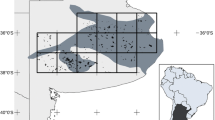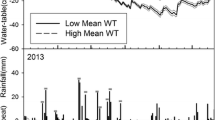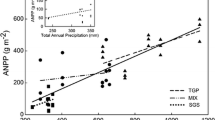Abstract
Aboveground net primary production (NPP) and surface water chemistryvariables were monitored in a lacustrine sedge fen and a bog for four years.There were no significant differences in precipitation, mean growing seasonannual temperature, and number of growing degree days from 1991 to 1994. Themean annual water levels in the lacustrine sedge fen differed significantly,whereas they were similar in the bog during these four years. We measured 15surface water variables in the lacustrine sedge fen and the bog, and foundthat only two correlated significantly with water level fluctuations. In thelacustrine sedge fen, calcium correlated positively (r2= 0.56) and nitrate correlated negatively (r2 =0.20) with water levels. In the bog, potassium correlated positively(r2 = 0.88) and total dissolved phosphorus correlatednegatively (r2 = 0.62) with water levels. The remainingchemical variables showed no significant correlations with water levelfluctuations. Net primary production of the different vegetation strataappeared to respond to different environmental variables. In the lacustrinesedge fen, graminoid production was explained to a significant degree bywater levels (r2 = 0.53), whereas shrub production wasexplained to a significant degree by surface water chemistry variables, suchas nitrate (r2 = 0.74) and total phosphorus(r2 = 0.22). In the bog, temperature was the onlyvariable that explained moss production to a significant degree(r2 = 0.71), whereas ammonium explained graminoidproduction (r2 = 0.66) and soluble reactive phosphorusexplained shrub production to significant degrees (r2 =0.71). There are few direct data on the impact of climatic warming in borealwetlands, although paleoecological and 2×CO2 model datahave provided some indications of past and possibly future changes invegetation composition, respectively. Our results suggest that thelacustrine sedge fen may succeed to a bog dominated by Sphagnum spp. andPicea mariana, whereas the bog may succeed to an upland-type forestecosystem.
Similar content being viewed by others
References
Anderson, L. E., 1990. A checklist of Sphagnumin North America north of Mexico. Bryologist 93: 500–501.
Anderson, L. E., H. A. Crum & W. R. Buck, 1990. List of the mosses of North America north of Mexico. Bryologist 93: 448–499.
Armentano, T. V. & E. S. Menges, 1986. Patterns of change in the carbon balance of organic soilwetlands of the temperate zone. J. Ecol. 74: 755–774.
Backéus, I., 1990. Production and depth distribution of fine roots in a boreal open bog. Ann. bot. fenn. 27: 261–265.
Backéus, I., 1988. Weather variables as predictors of Sphagnum growth in a bog. Holarctic Ecol. 11: 146–150.
Bayley, S. E., J. Zoltek Jr., A. J. Herman, T. J. Dolan & L. Tortora, 1985. Experimental manipulation of nutrients and water in a freshwater marsh: Effects on biomass, decomposition, and nutrient accumulation. Limnol. Oceanogr. 30: 500–512.
Bernard, J.M. & E. Gorham, 1978. Life history aspects of primary production in sedge wetlands. In R. E. Good, D. F. Whigham & R. L. Simpson (eds), Freshwater Wetlands: Ecological Processes and Management Potential. Academic Press, New York, NY, USA: 39–53.
Bridgham, S. D., S. P. Faulkner & C. J. Richardson, 1991. Steel rod oxidation as a hydrologic indicator in wetland soils. Soil Sci. Soc. am. J. 55: 856–862.
Brock, C. M. & R. Bregman, 1989. Periodicity in growth, productivity, nutrient content and decomposition of Sphagnum recurvum var. mucronatumin a fen woodland. Oecologia 80: 44–52.
Chapin III, F. S., N. Fetcher, K. Keilland, K. R. Everett & A. E. Linkens, 1988. Productivity and nutrient cycling of Alaskan tundra: Enhancement of flowing soil water. Ecology 69: 693–702.
Clymo, R. S., 1983. Peat. In A. J. P. Gore (ed.), Mires: Swamp, Bog, Fen and Moor. Vol. A, General Studies. Elsevier Scientific Publishing, Amsterdam, The Netherlands: 159–224.
Clymo, R. S., 1970. The growth of Sphagnum:Methods of measurement. J. Ecol. 58: 13–49.
Damman, A. W. H., 1978. Distribution and movement of elements in ombrotrophic peat bogs. Oikos 30: 480–495.
Dhillion, S. S., 1994. Ectomycorrhizae, arbuscular mycorrhizae, and Rhizoctoniasp. of alpine and boreal Salixspp. in Norway. Arc. Alp. Res. 26: 304–307.
Dise, N. B., E. Gorham & E. S. Verry, 1993. Environmental factors controlling methane emissions from peatlands in northern Minnesota. J. Geophys. Res. Atmos. 98: 10583–10594.
Droste, M., 1984. Above ground standing crop and production of Carex gracilisCURT. in a fen. Hydrobiol. J. 100: 533–538.
Ecoregions Working Group, 1989. Ecoclimatic regions of Canada, first approximation. Canada Committee on Ecological Land Classification, Ecological Land Series, No. 23. Sustainable Development Branch, Canadian Wildlife Service, Conservation and Protection, Environment Canada, Ottawa, Ontario, Canada, 118 pp.
Environment Canada, 1982. Canadian Climate Normals, 1951–1980, Temperature and Precipitation, Prairie Provinces. Canadian Climate Program, Ottawa, Ontario, Canada, 429 pp.
Flannigan, M. D. & C. E. Van Wagner, 1991. Climate change and wildfire in Canada. Can. J. For. Res. 21: 66–72.
Gignac, L. D. & D. H. Vitt, 1994. Responses of northern peatlands to climate change: Effects on bryophytes. J. Hattori Bot. Lab. 75: 119–132.
Gignac, L. D., D. H. Vitt, S. C. Zoltai & S. E. Bayley, 1991. Bryophyte response surfaces along climate, chemical, and physical gradients in peatlands in western Canada. Nova Hedwigia 53: 27–71.
Glaser, P. H. & J. A. Janssens, 1986. Raised bogs in eastern North America: Transitions in landforms and gross stratigraphy. Can. J. Bot. 64: 395–415.
Glaser, P. H. J. A. Janssens & D. I. Siegel, 1990. The response of vegetation to chemical and hydrological gradients in the Lost River Peatland, northern Minnesota. J. Ecol. 78: 1021–1048.
Gorham, E., 1994. The future of research in Canadian peatlands: A brief survey with particular reference to global change. Wetlands 14: 206–215.
Gorham, E., 1991. Northern peatlands: Role in the carbon cycle and probable responses to climate warming. Ecol. Applic. 1: 182–195.
Gorham, E., 1990. Biotic impoverishment in northern peatlands. In G. M. Woodwell (ed.), The Earth in Transition: Patterns and Processes of Biotic Impoverishment. Cambridge University Press, Cambridge, England: 65–98.
Gorham, E., 1988. Canada’s peatlands: Their importance for the global carbon cycle and possible effects of ‘greenhouse’ climatic warming. Transactions of the Royal Society of Canada, Series V, 3: 21–23.
Gorham, E., 1974. The relationship between standing crop in sedge meadows and summer temperature. J. Ecol. 62: 487–491.
Hillman, G. R., J. D. Johnson & S. K. Takyi, 1990. The Canada-Alberta wetlands drainage and improvement for forestry program. qForestry Canada/Alberta Forestry, Lands and Wildlife, Project # 1413-1417-86, 66 pp.
Laitinen, J., 1990. Periodic moisture fluctuations as a factor affecting mire vegetation. Aquilo. Ser. Bot. 28: 45–55.
Lichti-Federovich, S., 1970. The pollen stratigraphy of a dated section of late Pleistocene lake sediment core from central Alberta. Can. J. Earth Sci. 7: 938–945.
Moore, T. R., 1994. Trace gas emissions from Canadian peatlands and the effects of climate change. Wetlands 14: 223–228.
Moore, T. R., 1989. Growth and net production of Sphagnumat five fen sites, subarctic eastern Canada. Can. J. Bot. 67: 1203–1207.
Munn, D. A. & W. A. Jackson, 1978. Nitrate and ammonium uptake by rooted cuttings of sweet potato. Agron. J. 70: 312–316.
Nicholson, B. J., L. D. Gignac, S. E. Bayley & D. H. Vitt, 1997. Vegetation responses to global warming: Interactions between boreal forest wetlands and regional hydrology. In S. J. Cohen (ed.), Mackenzie Basin Impact Study (MBIS). Environment Canada, University of British Columbia, Vancouver, B. C., Canada: 125–145.
Packer, J. G., 1983. Flora of Alberta by E. H. Moss, 2nd edn. University of Toronto Press, Toronto, Ontario, Canada, 687 pp.
Pakarinen, P., 1978. Production and nutrient ecology of three Sphagnum species in southern Finnish raised bogs. Ann. bot. fenn. 15: 15–26.
Read, D. J. & K. Haselwandter, 1981. Observations of the mycorrhizal status of some alpine plant communities. New Phytol. 88: 341–352.
Reader, R. J., 1978. Primary production in northern bog marshes. In R. E. Good, D. F. Whigham & R. L. Simpson (eds), Freshwater Wetlands: Ecological Processes and Management Potential. Academic Press, New York, NY, USA: 53–63.
Richardson, C. J., D. L. Tilton, K. A. Kadlec, J. P. M. Chamie & W.A. Wentz, 1978. Nutrient dynamics of northern wetland ecosystems. In R. E. Good, D. F. Whigham & R. L. Simpson (eds), Freshwater Wetlands: Ecological Processes and Management Potential. Academic Press, New York, NY, USA: 217–241.
Roulet, N., R. Ash, W. Quinton & R. R. Moore, 1993. Methane flux from drained northern peatlands: Effects of a persistent water table lowering on flux. Global biogeochem. Cycles 7: 749–769.
SAS Institute Inc., 1989. SAS/STAT Release en6.08 Edition. Cary, NC, USA.
Shedlock, R. J., D. A. Wilcox, T. A. Thompson & D. A. Cohen, 1993. Interactions between ground water and wetlands, southern shore of Lake Michigan, USA. J. Hydrol. 141: 127–155.
Sjörs, H., 1991. Phyto-and necromass above and below ground in a fen. Holarctic Ecol. 14: 208–214.
SYSTAT Inc., 1992. SYSTAT Version 5.2 Edition. Evanston, IL, USA.
Szumigalski, A. R. & S. E. Bayley, 1997. Net aboveground primary production in peatlands of central Alberta in relation to water levels and water chemistry. Écoscience 4: 385–393.
Szumigalski, A. R. & S. E. Bayley, 1996. Net aboveground primary production along a bog-rich fen gradient in central Alberta. Wetlands 16: 467–476.
Thormann, M. N. & S. E. Bayley, 1997a. Aboveground net primary production along a bog–fen–marsh gradient in southern boreal Alberta, Canada. Écoscience 4: 374–384.
Thormann, M. N. & S. E. Bayley, 1997b. Aboveground plant production and nutrient content of the vegetation of six peatlands in Alberta, Canada. Plant Ecology 131: 1–16.
Ullrich, W. R., M. Larsson, C. M. Larsson, S. Lesch & A. Novacky, 1984. Ammonium uptake in Lemna gibbaGl. and related membrane potential changes and inhibition of anion uptake. Physiol. Plant. 61: 369–376.
Vance, R. E., A. B. Beaudoin & B. H. Luckman, 1995. The paleological record of 6 ka bp climate in the Canadian prairie provinces. Géographie physique de Quaternaire 49: 81–98.
Vasander, H., 1982. Plant biomass and production in virgin, drained and fertilized sites in a raised bog in southern Finland. Ann. bot. fenn. 19: 103–125.
Vitt, D. H. & P. Pakarinen, 1977. The bryophyte vegetation, production, and organic components of Truelove Lowland. In L. C. Bliss (ed.), Truelove Lowland, Devon Island, Canada: A High Arctic Ecosystem. University of Alberta Press, Edmonton, Alberta, Canada: 225–244.
Vitt, D. H., S. E. Bayley, L. Halsey & T.-L. Jin, 1995. Seasonal variation in water chemistry over a bog-rich fen gradient in continental western Canada. Can. J. Fish. aquat. Sci. 52: 587–606.
Wallén, B., 1993. Methods for studying belowground production in mire ecosystems. Suo 43: 155–162.
Wallén, B., U. Falkengren-Grerup & N. Malmer, 1988. Biomass, productivity and relative rate of photosynthesis at different water levels on a south Swedish peat bog. Holarctic Ecol. 11: 70–76.
Yavitt, J. B., R. K. Wieder & G. E. Lang, 1993. CO2 and CH4 dynamics of a Sphagnum-dominated peatland in West Virginia. Global biogeochem. Cycles 7: 269–274.
Zar, H. H., 1984. Biostatistical Analyses, 2nd edn. Prentice Hall, Englewood Cliffs, New Jersey, NJ, USA, 718 pp.
Zoltai, S. C. & D. H. Vitt, 1990. Holocene climate change and the distribution of peatlands in western interior Canada. Quat. Res. 33: 231–240.
Author information
Authors and Affiliations
Rights and permissions
About this article
Cite this article
Thormann, M.N., Bayley, S.E. & Szumigalski, A.R. Effects of hydrologic changes on aboveground production and surface water chemistry in two boreal peatlands in Alberta: Implications for global warming. Hydrobiologia 362, 171–183 (1997). https://doi.org/10.1023/A:1003194803695
Issue Date:
DOI: https://doi.org/10.1023/A:1003194803695




